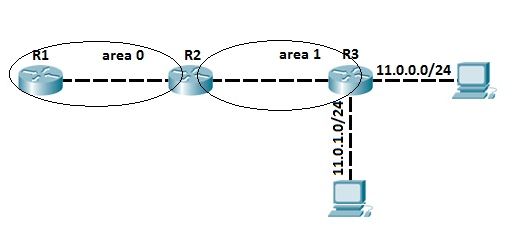Route summarization helps reduce OSPF traffic and route computation. OSPF, unlike EIGRP, doesn’t support automatic summarization. Also, unlike EIGRP, where you can summarize routes on every router in an EIGRP network, OSFP can summarize routes only on ABRs and ASBRs.
The following command is used for OSPF summarization:
(config-router) area AREA_ID range IP_ADDRESS MASK
To better understand OSPF summarization, consider the following example network:

All three routers are running OSPF and exchanging routers. Before OSPF summarization is configured, the router R1 inside the backbone area has two entries for the networks 11.0.0.0/24 and 11.0.1.0/24 in its routing table.

We could summarize these two subnets on R2, so that R1 receive only one routing update for both subnets. To do that, the following command can be used on R2:

Now, R1 has only one entry in its routing table for R3’s directly connected subnets:

NOTE
Be careful with summarization. In this case, router R1 thinks that R2 has routes for all subnets in the range 11.0.0.0 – 11.0.255.255. When summarizing, try to be as specific as possible.
OSPF summary
Here is a list of the most important OSPF features:
- link-state routing protocol
- classless routing protocol
- supports VLSM (Variable Length Subnet Mask)
- converges fast
- uses the concept of areas
- uses the multicast address for routing updates (224.0.0.5 and 224.0.0.6)
- sends partial routing updates
- supports only equal-cost load balancing
- manual summarization can be done only on ABRs and ASBRs
- uses interface cost as a metric
- uses the SPF algorithm to calculate the best paths
- open standard
- each router inside an area has the same topology table
- supports clear-text and MD5 authentication
Differences between OSPF and EIGRP
The following table lists the differences between OSPF and EIGRP:

Comparing internal routing protocols (IGPs)
The following table lists the differences between the three most popular interior routing protocols:
| Feature | RIP | EIGRP | OSPF |
|---|---|---|---|
| Type | distance vector | hybrid | distance vector |
| Metric | hop count | bandwidth and delay | cost |
| Speed of convergence | slow | fast | fast |
| Routing | classful (RIPv1), classless(RIPv2) | classless | classless |
| Updates | periodical broadcast (RIPv1), multicast(RIPv2) | multicast | multicast |
| Manual summarization | no (RIPv1), yes (RIPv2) | yes | yes |
| Supported on non-Cisco routers | yes | no | yes |
| Configuration complexity | easy | medium | hard |